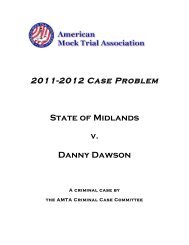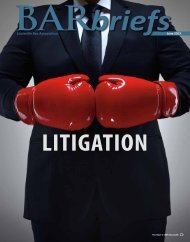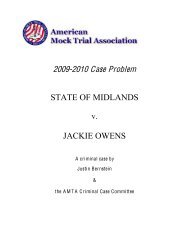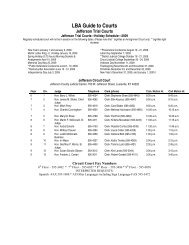Corporate Affiliate Conflicts of Interest - Louisville Bar Association
Corporate Affiliate Conflicts of Interest - Louisville Bar Association
Corporate Affiliate Conflicts of Interest - Louisville Bar Association
Create successful ePaper yourself
Turn your PDF publications into a flip-book with our unique Google optimized e-Paper software.
Playing by Kentucky Rules<br />
Researching the Kentucky Rules <strong>of</strong> Evidence<br />
Kurt X. Metzmeier<br />
“If you’re gonna play stickball in<br />
Canarsie, learn Brooklyn rules!”<br />
–Jack McCoy, “Law & Order: Blue Bamboo,” 1994.<br />
The Kentucky Rules <strong>of</strong> Evidence (KRE) are as<br />
an integral part <strong>of</strong> trial practice as the surprise<br />
confession under a brutal cross-examination<br />
is to the final act <strong>of</strong> a TV lawyer drama.<br />
Because <strong>of</strong> this, many newer attorneys may<br />
be shocked to find out that before 1992, Kentucky<br />
had no codified evidence rules.<br />
Indeed, for two centuries Kentucky lawyers<br />
found the rules <strong>of</strong> evidence in the case law, using<br />
digests and, when there was no state case<br />
on point, in learned treatises like Greenleaf<br />
on Evidence and McCormack on Evidence.<br />
Before the Kentucky Rules <strong>of</strong> Evidence<br />
The 1970s saw the publication <strong>of</strong> guides to<br />
Kentucky evidence precedents like Richardson’s<br />
Kentucky Law <strong>of</strong> Evidence, Civil<br />
and Criminal (1976) and Lawson’s Kentucky<br />
Evidence Law Handbook (1976).<br />
Lawson’s treatise was particularly influential.<br />
It was first published by the Kentucky Administrative<br />
Office <strong>of</strong> the Courts (AOC). The<br />
AOC was the organizational arm <strong>of</strong> the state<br />
judicial branch, which had been empowered<br />
by a 1975 state constitutional amendment to<br />
create institutions to unify Kentucky’s courts.<br />
The AOC enlisted University <strong>of</strong> Kentucky law<br />
pr<strong>of</strong>essor Robert G. Lawson to arrange all<br />
“significant decisions” on Kentucky evidence<br />
law in an orderly arrangement <strong>of</strong> black-letter<br />
rules with attached cases and commentary.<br />
The work was intended “as a point <strong>of</strong> embarkation<br />
for judges and practitioners” to<br />
help them find “quick answers” to evidence<br />
questions.<br />
The original Kentucky Evidence Law Handbook<br />
went into additional editions and became<br />
the authority on the rules <strong>of</strong> evidence in<br />
Kentucky, assisted by the respect Bob Lawson<br />
has garnered as the evidence pr<strong>of</strong>essor for<br />
generations <strong>of</strong> Kentucky lawyers and from<br />
his hard work in a variety <strong>of</strong> legal reform<br />
efforts in the state.<br />
The Adoption <strong>of</strong> the KRE<br />
As useful as Lawson’s Handbook was, it was<br />
no substitute for a comprehensive code <strong>of</strong><br />
evidence rules. In the 1980s, the Kentucky<br />
Evidence Rules Committee was established<br />
to create such a code.<br />
Chaired from 1987 on by Lawson, the Rules<br />
Committee studied Kentucky precedents,<br />
various model codes and the Federal Rules<br />
<strong>of</strong> Evidence that had been adopted in 1975.<br />
While the committee sought to “strive for uniformity<br />
with the Federal Rules <strong>of</strong> Evidence,”<br />
they “carefully prepared for each rule a commentary<br />
which should be used in application<br />
and construction <strong>of</strong> that rule.” (KRE, Study<br />
Committee’s Prefatory Note). A final draft<br />
report <strong>of</strong> the committee was completed in<br />
1989, and the Study Committee Notes were<br />
completed in July 1992.<br />
The final version <strong>of</strong> the KRE was adopted as a<br />
law by the Kentucky Legislature in 1992 (1992<br />
Ky. Acts ch. 324), a move thought necessary<br />
because the new rules repealed existing<br />
statutes.<br />
<strong>Interest</strong>ingly, the Kentucky<br />
Supreme Court, which normally<br />
sets rules <strong>of</strong> court and<br />
perhaps was concerned that<br />
the legislature had intervened<br />
on some <strong>of</strong> its turf,<br />
also adopted “so much <strong>of</strong> the<br />
Kentucky Rules <strong>of</strong> Evidence…<br />
as comes within the rule making<br />
power <strong>of</strong> the Court, pursuant<br />
to Ky. Const. sec. 116” by an order dated<br />
May 12, 1992.<br />
Pr<strong>of</strong>essor Lawson has discussed the KRE’s<br />
unique status as both statute and court rule,<br />
and the constitutional issues it raises, in an<br />
important pair <strong>of</strong> articles, Interpretation <strong>of</strong><br />
the Kentucky Rules <strong>of</strong> Evidence—What<br />
Happened to the Common Law, 87 Ky. L.J.<br />
517 (1998–99) and Modifying the Kentucky<br />
Rules <strong>of</strong> Evidence—A Separation <strong>of</strong> Powers<br />
Issue, 88 Ky. L.J. 525 (1999–2000). (The two<br />
articles are also valuable in that they give a<br />
detailed history <strong>of</strong> the KRE’s adoption from<br />
someone in the midst <strong>of</strong> the reform).<br />
Researching the KRE<br />
The best place to start researching an evidence<br />
question is the annotated KRE in the rules<br />
volumes <strong>of</strong> either the Michie’s or Baldwin’s<br />
KRS. Both sets are annotated with cases citing<br />
the current rule and sometimes with cases<br />
prior to the adoption <strong>of</strong> that KRE that editors<br />
nonetheless believe are useful. They also give<br />
references to relevant treatise sections and to<br />
law review articles.<br />
One thing to remember is that the Michie’s set<br />
is published by LexisNexis and thus tends to<br />
cite to LexisNexis treatises, and the Baldwin<br />
set is a Thomson West product and favors<br />
its own publications, especially Kentucky<br />
Practice treatises.<br />
Kentucky Treatises<br />
Treatises have always played a major role in<br />
helping lawyers apply the rules <strong>of</strong> evidence.<br />
Lawson’s Kentucky Evidence Law Handbook,<br />
4th (LexisNexis) is just as valuable as it always<br />
has been and it is not unusual for the first<br />
question by a senior lawyer on an evidence<br />
issue to be “what does Lawson say?” Lawson<br />
[I]t is<br />
not unusual for the<br />
first question by a senior<br />
lawyer on an evidence<br />
issue to be “what does<br />
Lawson say?”<br />
is still a handbook on general Kentucky evidence<br />
law and as such is organized topically<br />
by the leading issues in the field.<br />
Richard H. Underwood and Glen Weissenberger’s<br />
Kentucky Evidence Courtroom<br />
Manual (LexisNexis) is more trial practice<br />
oriented and is organized by KRE section<br />
so that lawyers can find answers quickly<br />
from the counsel’s table. Each entry has the<br />
rule boxed, with commentary, a quick<br />
comparison to the federal rule,<br />
summaries <strong>of</strong> significant cases,<br />
and cites to other treatises.<br />
One useful feature is that it<br />
duplicates the 1992 KRE<br />
Study Committee Notes in<br />
an appendix.<br />
There are other Kentucky<br />
treatises that partially cover<br />
evidence issues, especially some<br />
<strong>of</strong> the volumes <strong>of</strong> Thomson West’s<br />
Kentucky Practice series. Criminal law<br />
practitioners will find Leslie W. Abramson’s<br />
Criminal Practice and Procedure (Thomson<br />
West) very helpful. Evidence issues play a<br />
leading role in David N. Finley and Erin<br />
Carlson’s Kentucky Motions in Limine and,<br />
to a lesser degree, in Gary Weiss’ Trial<br />
Practice. For those Kentucky rules closely<br />
aligned with the Federal Rules <strong>of</strong> Evidence,<br />
Weissenberger’s Federal Evidence (LexisNexis)<br />
and Charles B. Gibbons’ Federal<br />
Rules <strong>of</strong> Evidence with Trial Objections<br />
(Thomson West) are valuable supplemental<br />
references.<br />
Legislative History<br />
The most important part <strong>of</strong> the legislative<br />
history <strong>of</strong> the original KRE is the 1992<br />
Study Committee Notes. They were published<br />
first in Kentucky Rules <strong>of</strong> Evidence, a 1992<br />
publication <strong>of</strong> the University <strong>of</strong> Kentucky<br />
College <strong>of</strong> Law Office <strong>of</strong> Continuing Legal<br />
Education. Robert G. Lawson, William S.<br />
Cooper and William H. Fortune’s Kentucky<br />
Rules <strong>of</strong> Evidence, 2d is a 2002 update <strong>of</strong><br />
that early edition.<br />
The 2002 edition has one table comparing<br />
the KRE with both the Federal Rules <strong>of</strong><br />
Evidence and the former Kentucky case<br />
law rules, and another table comparing<br />
the federal “general authority references”<br />
with the 1992 Kentucky study committee<br />
commentary. As mentioned earlier, the<br />
Study Committee Notes can also be found<br />
in Underwood & Weissenberger Kentucky<br />
Evidence Courtroom Manual.<br />
A thorough researcher will also want to examine<br />
the Kentucky Rules <strong>of</strong> Evidence: Final<br />
Draft <strong>of</strong> the Evidence Rules Study Committee,<br />
published by the Kentucky <strong>Bar</strong> <strong>Association</strong><br />
in 1989. The bulk <strong>of</strong> what was ultimately<br />
adopted as the KRE is outlined in this draft<br />
report, which only underwent a few changes<br />
before the final evidence rules were adopted<br />
three years later.<br />
Conclusion<br />
For writers <strong>of</strong> a Law & Order or CSI episode,<br />
a point <strong>of</strong> evidence is just a device around<br />
which to build a dramatic plot twist. But for<br />
lawyers, the rules <strong>of</strong> evidence regulate how<br />
their cases are presented, and whether or<br />
not they can convince a jury to rule on their<br />
clients’ behalf.<br />
It’s not a game <strong>of</strong> stickball, and they play by<br />
Kentucky rules.<br />
Kurt X. Metzmeier is the<br />
associate director <strong>of</strong> the<br />
Law Library and Associate<br />
Pr<strong>of</strong>essor <strong>of</strong> Legal Bibliography<br />
at the University <strong>of</strong><br />
<strong>Louisville</strong> School <strong>of</strong> Law.<br />
He is the editor and principal<br />
author <strong>of</strong> the Kentucky Legal<br />
Research Manual, 3d. •<br />
Experience Counts<br />
Over 2,000 full settlement conferences<br />
From sensitive, pre-litigation conflicts to complex,<br />
multi-party employment, personal injury and business litigation.<br />
www. loubar.org October 2010<br />
7







